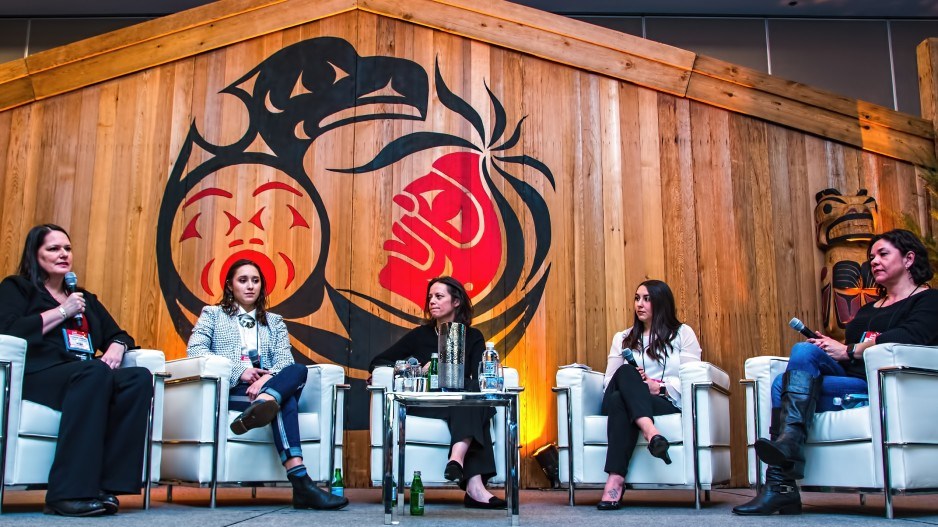When it comes to international capital markets and mineral exploration, British Columbia has a perception problem - that the province is a risky place to invest because 110 per cent of its land base is claimed by First Nations.
That's a perception Corinne McKay, secretary-treasurer of Nisga'a Lisims Government, said she encountered when she attended a mining symposium in London in 2018.
Responding to a question about unsettled land claims in B.C., McKay pointed out that when the Nisga'a signed a treaty nearly 20 years ago, her nation got seven per cent of its claimed territory as title land, not 100 per cent.
But apart from the unsettled land question, international investors also read the newspapers, which have been filled with headlines about First Nations blockading pipelines in B.C.
They seldom read about all the First Nations in B.C. who are eagerly seeking equity positions in those very pipelines, or partnering with mining companies to bring new mines into production.
B.C.'s perception problem is one the BC Regional Mining Alliance (BCRMA) - which includes the Nisga'a and Tahltan - has been trying to counter.
There are pockets of B.C. where resource development may still founder due to opposition from First Nations. But the Golden Triangle, which hugs the Alaska border in northwest B.C., isn't one of them, as delegates attending last week's Association for Mineral Exploration (AME) Roundup conference heard.
The BCRMA is a partnership between the B.C. government, the Nisga'a and Tahltan and five mining companies with properties being developed in the Golden Triangle.
The message they are trying to spread is that, when it comes to mining, B.C. is open for business and it's a sector that enjoys the support of First Nations - at least in northwestern B.C.
"We know that it's a growth industry for many of our people, and we know that there's potential and we'd like to capitalize on that," McKay said. "There's no dignity in unemployment, so if there's an opportunity to provide capacity for training and employment, our people are there."
The region is geologically blessed with gold, silver and copper, has power from the Northwest Transmission Line and is home to supportive First Nations.
The Tahltan have had a particularly good relationship with mining and have spent considerable resources and energy on capacity building and skills training. The result, according to Tahltan elder Jerry Asp, is full employment for his people.
Asp was inducted into the Canadian Mining Hall of Fame for his efforts to bring his people into the mining sector.
"We had 98 per cent unemployment in the winter and 65 per cent unemployment in the summer in our nation," Asp told Business in Vancouver. "And we took it to zero."
Citing a presentation given by Tahltan Central Government President Chad Day, Asp said 400 Tahltan people are employed in the mining sector - 300 in operating mines like Red Chris and 100 in exploration.
"We're earning somewhere in the neighbourhood of $30 million annually in wages to the Tahltan," Asp said.
There are a dozen prospective new mines in the Golden Triangle at various stages of development, but to date, only two have gone into operation since the $746 million Northwest Transmission Line was completed in 2014 - Red Chris copper and Brucejack gold mine.
The next new mine to be built in the region may be the Premier-Dilworth-Red Mountain project. Last year, Ascot Resources (TSX:AOT), which owned the Premier brownfield project, acquired the greenfield Red Mountain project when it bought out IDM Mining.
"We have a hub and a spoke concept," said Kristina Howe, Ascot's vice-president of investor relations. "We have a central mill and we've got four different deposits. Red Mountain would be one of the deposits that would feed that mill."
The project is in the southern end of the Golden Triangle in Nisga'a traditional territory. Last year, the company signed a benefits agreement with the Nisga'a that includes cash payments and training and employment for Nisga'a people.
But new mines like Ascot's project have been a lot slower in coming than the provincial government had hoped. Peter Robb, assistant deputy minister of energy, mines and petroleum resources, said the construction of the Northwest Transmission Line was expected to kick-start a whole new generation of mines in the northwest.
"It hasn't had the impact we wanted yet," Robb said. "We thought mines would be flying off the shelf and really come together quite quickly."
Mines in the Golden Triangle are getting permitted but not getting built. A big part of the problem is that mining and exploration simply isn't attracting the risk capital that it once did.
And it's not just a B.C. problem, although the perception that B.C. is a risky place to try to build a mine doesn't help.
There has been a flight of investor capital from the junior mining sector, especially among the "generalist" investor, Matt Dugaro, executive director of investment banking for CIBC, said at a panel discussion on finance at last week's AME conference.
At the beginning of the decade, about $8 billion in equity financing went into the junior mining sector, said Joe Mazumdar, an analyst with Exploration Insights; at the end of the decade it was down to $2.1 billion.
About half the money going into exploration and development projects is coming from private placements, Dugaro said, with the rest coming from other financing sources like streaming.
"We need to see the generalist investor come back to the sector," he said.
As for international investors and mining majors, the mining alliance wants to make it clear: they can get mines built in B.C.
"You have to be able to figure out Indigenous relations and you have to be able to figure out water quality," Robb said. "If you can figure out those two things in British Columbia, you can build a mine."


